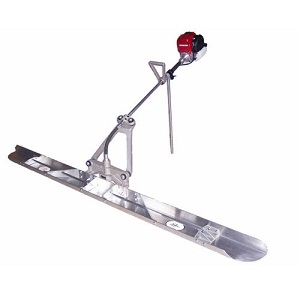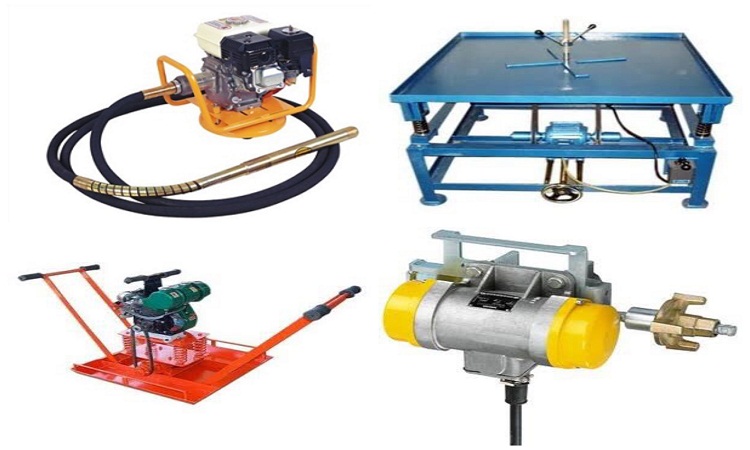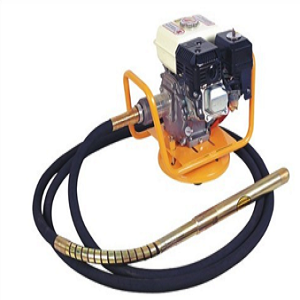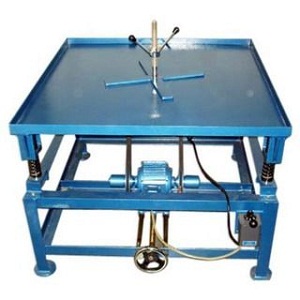Compaction of concrete is best done by vibration. Rodding, tamping and spading are all ways of removing entrapped air from concrete and compacting it; however, the best and most effective method is vibration. The concrete mix gets fluidized on vibration, and the internal friction between the aggregate particles reduces, resulting in entrapped air rising to the surface. On continued vibration maximum entrapped air is driven out and that is the time when most of the consolidation takes place.
On vibration of an over wet concrete mix, the coarser aggregates settle down. Compaction improves the density of concrete, strength of concrete, bonding with reinforcement steel, minimizes surface blemishes, and also to a great extent helps in improving the durability of the structure.
Broadly Vibrators Can be Classified into Two
- Internal vibrators
- External vibrators
Generally, mechanical compaction is done using internal i.e. using immersion or poker vibrators. This compaction method is preferred because the poker works directly on the concrete and can be moved from position to position very easily and quickly.
Internal Vibrators
The internal immersion vibrators are of two types:
- The head contains only a vibratory mechanism and a flexible shaft connects it to the drive which is operated by an electric motor or petrol or diesel engine. They are portable and convenient to use along with a separate motor.
- The motor and vibratory mechanisms are both in the head. This tape of vibrators is operated electrically or by compressed air.
Both these vibrators equally match each other in their performance; the only primary difference between the two is the location of the vibrator’s power unit either inside or outside the vibrating head.
Indigenously made vibrators do not have a drive inside the head. This may be mainly due to economic reasons. Immersion vibrators with a separate motor are quite commonly used. Generally, electric motor drives are preferred whenever an electric power supply is easily available. Petrol or diesel run motor is only used in cases where electric power is not easily available.
The flexible shaft vibrators with separate drive motors have better applicability for different requirements. They are lighter in weight and easier to handle than the motor-in-head type of vibrators.
For proper compaction, it is essential that the operator does not get tired due to the heavyweight of the needle and the flexible shaft. It is often essential to change the operators after some time or to have one person handling the needle and another motor.
The main disadvantage of electric flexible shaft vibrators is their loss of power under load (in concrete). This power loss lowers the frequency and the ability to remove entrapped air from the mortar. Power loss problems can be avoided to a certain extent by using the correct length of the shaft or vibrator head to match the capacity of the motor. However, power loss due to the low slump of concrete is unavoidable as concrete workability cannot be altered once it is in the form.
The flexible shaft is also particularly susceptible to strain damage due to bad and rough handling. The flexible shaft vibrator can be a high maintenance tool especially if it is repeatedly handled roughly or the needle repeatedly hits the reinforcement steel or formwork during compaction.
The motor-in-head vibrators are initially more expensive. However, due to their design features, they are less vulnerable to damage and have much fewer maintenance problems. Therefore, their life cycle cost may work out to be nearly the same as flexible shaft vibrators. However, the connecting hose between the needle and power supply source protects only the power cable and not the flexible drive shaft hence it is more delicate and gets damaged more than the tougher flexible hose, housing the flexible shaft.
External Vibrators
External vibrators can be form vibrators, vibrating tables, surface screed vibrators, plate vibrators, vibratory rollers vibratory hand floats, or trowels.
Form Vibrators
Form vibrators are to be securely attached to the outside of the formwork. They are generally used under the following circumstances:
- Compaction of concrete is required to be done in very thin or very densely congested reinforced sections.
- Moreover to internal vibration, compaction is needed to be done especially in the cover area where at times needle to do compaction sufficiently.
- Compaction of very stiff concrete is needed to be done because such concrete can’t be compacted by internal vibrators.
The performance of these vibrators when directly attached to formwork is not generally satisfactory. The vibrator is mounted on a steel plate that is attached to the I-beam or a channel that runs along the formwork touching the form stiffeners. The formwork needs to be appropriately designed to transfer the vibrations to the concrete without itself getting displaced or opening up.
The spacing of the form vibrators has to be such, that intensity of vibration is uniformly applied over the concrete within the formwork. The compaction time of form vibrators is normally between 1 to 2 minutes. Form vibrators shouldn’t be used on top of the vertical formwork. Generally, form vibrators should be fixed 1000mm below the top finished level of the concrete. The use of form vibrators at top locations will generally cause the separation of concrete from the formwork. Because of formwork being inefficiently stiffened at the top it results in, in and out movement causing the separation.
A heavily reinforced section, wherein an internal vibrator cannot penetrate, is sometimes helpful to vibrate reinforcing bars by attaching form vibrators to exposed or projecting bars. This helps entrapped air underneath the reinforcing bars to get released and increase the bond between the reinforcement and the surrounding concrete.
Form vibrators, if used in addition to internal vibrators, help to remove entrapped air along the concrete surface giving a much superior finish. Generally, tapping with a wooden mallet or wooden hammer on the external face of the formwork also helps remove entrapped air which generally blemishes the concrete surface, in spite of adequate internal vibration.
Vibrating Table
They are mainly used in precasting plants or concrete testing laboratories. They are equipped with controls to vary frequency and amplitude to be compacted or the concrete consistency.
In this type of compaction method, the formwork is clamped to the vibrator instead of another way round as in the case of form vibrators. However, as in the case of form vibrators this case also the form and the concrete are both vibrated together.
Medium workable concrete mixes generally require a higher frequency of vibration than stiff mixes. It’s observed that increasing the frequency and decreasing the amplitude as vibration progresses improves consolidation by using this type of vibrator.
Surface Vibrators
This type of vibrator is used to consolidate concrete in the floor and another type of flat works. The surface vibrators apply vibration through a flat plate or a beam directly on the top surface of the concrete. It is recommended not to use these vibrators when the concrete slump is in excess of 75mm, as it causes excess accumulation of mortar at the top causing loss of strength on the surface and subsequent loss of wear resistance. Vibrating screeds give positive control of the strike-off operation and result in a great deal of saving in labor for leveling and finishing. However, surface vibrators must not be operated after the control has been adequately consolidated.
Surface vibration is least effective along the edges and corners, hence a poker vibrator should compact the concrete along the entire form edge immediately before the vibration by surface vibrator starts.
Screed vibrators are generally recommended for the consolidation of slabs and floors up to 150mm thickness if they are reinforced or up to 200mm thickness if they are not reinforced. Internal vibration is necessary for all slabs over 200mm thick and for all slabs of lesser thickness with reinforcing steel, conduits, or another embedment.






